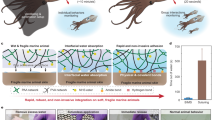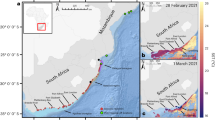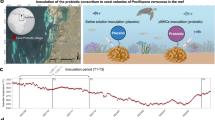Abstract
Biomaterials connect organisms to their environments. Their function depends on biological, chemical and environmental factors, both at the time of creation and throughout the life of the material. Shifts in the chemistry of the oceans driven by anthropogenic CO2 (termed ocean acidification) have profound implications for the function of critical materials formed under these altered conditions. Most ocean acidification studies have focused on one biomaterial (secreted calcium carbonate), frequently using a single assay (net rate of calcification) to quantify whether reductions in environmental pH alter how organisms create biomaterials1. Here, we examine biological structures critical for the success of ecologically and economically important bivalve molluscs. One non-calcified material, the proteinaceous byssal threads that anchor mytilid mussels to hard substrates, exhibited reduced mechanical performance when secreted under elevated conditions, whereas shell and tissue growth were unaffected. Threads made under high (>1,200 μatm) were weaker and less extensible owing to compromised attachment to the substratum. According to a mathematical model, this reduced byssal fibre performance, decreasing individual tenacity by 40%. In the face of ocean acidification, weakened attachment presents a potential challenge for suspension-culture mussel farms and for intertidal communities anchored by mussel beds.
This is a preview of subscription content, access via your institution
Access options
Subscribe to this journal
Receive 12 print issues and online access
$209.00 per year
only $17.42 per issue
Buy this article
- Purchase on Springer Link
- Instant access to full article PDF
Prices may be subject to local taxes which are calculated during checkout


Similar content being viewed by others
References
Kroeker, K. J., Kordas, R. L., Crim, R. N. & Singh, G. G. Meta-analysis reveals negative yet variable effects of ocean acidification on marine organisms. Ecol. Lett. 13, 1419–1434 (2010).
Ocean Acidification Due to Increasing Atmospheric Carbon Dioxide Policy document 12/05 (The Royal Society, 2005).
Feely, R. A., Sabine, C. L., Hernandez-Ayon, J. M., Ianson, D. & Hales, B. Evidence for upwelling of corrosive ‘acidified’ water onto the continental shelf. Science 320, 1490–1492 (2008).
Hoegh-Guldberg, O. et al. Coral reefs under rapid climate change and ocean acidification. Science 318, 1737–1742 (2007).
O’Donnell, M. J. et al. Ocean acidification alters skeletogenesis and gene expression in larval sea urchins. Mar. Ecol. Prog. Ser. 398, 157–171 (2010).
Melzner, F. et al. Food supply and seawater p CO 2 impact calcification and internal shell dissolution in the blue mussel Mytilus edulis. PLoS ONE 6, e24223 (2011).
Bibby, R., Widdicombe, S., Parry, H., Spicer, J. & Pipe, R. Effects of ocean acidification on the immune response of the blue mussel Mytilus edulis. Aquat. Biol. 2, 67–74 (2008).
Gaylord, B. et al. Functional impacts of ocean acidification in an ecologically critical foundation species. J. Exp. Biol. 214, 2586–2594 (2011).
FAO Yearbook: Fishery and Aquaculture Statistics, 2009 (Statistics and Information Service of the Fisheries and Aquaculture Department, 2011).
Carrington, E. & Gosline, J. M. Mechanical design of mussel byssus: Load cycle and strain rate dependence. Am. Malacol. Bull. 18, 135–142 (2004).
Harrington, M. J. & Waite, J. H. Holdfast heroics: Comparing the molecular and mechanical properties of Mytilus californianus byssal threads. J. Exp. Biol. 210, 4307–4318 (2007).
Bell, E. & Gosline, J. Mechanical design of mussel byssus: Material yield enhances attachment strength. J. Exp. Biol. 199, 1005–1017 (1996).
Lee, H., Scherer, N. F. & Messersmith, P. B. Single-molecule mechanics of mussel adhesion. Proc. Natl Acad. Sci. USA 103, 12999–13003 (2006).
Zhao, H. & Waite, J. H. Linking adhesive and structural proteins in the attachment plaque of Mytilus californianus. J. Biol. Chem. 281, 26150–26158 (2006).
Waite, J. H. & Broomell, C. C. Changing environments and structure–property relationships in marine biomaterials. J. Exp. Biol. 215, 873–883 (2012).
Carrington, E. Seasonal variation in the attachment strength of blue mussels: Causes and consequences. Limnol. Oceanogr. 47, 1723–1733 (2002).
Denny, M. W. & Gaylord, B. Marine ecomechanics. Annu. Rev. Mar. Sci. 2, 89–114 (2010).
Denny, M. & Helmuth, B. Confronting the physiological bottleneck: A challenge from ecomechanics. Integr. Comput. Biol. 49, 197–201 (2009).
Wootton, J. T., Pfister, C. A. & Forester, J. D. Dynamic patterns and ecological impacts of declining ocean pH in a high-resolution multi-year dataset. Proc. Natl Acad. Sci. USA 105, 18848–18853 (2008).
Carrington, E., Moeser, G. M., Dimond, J., Mello, J. J. & Boller, M. L. Seasonal disturbance to mussel beds: Field test of a mechanistic model predicting wave dislodgment. Limnol. Oceanogr. 54, 978–986 (2009).
Lachance, A.A., Myrand, B., Tremblay, R., Koutitonsky, V. & Carrington, E. Biotic and abiotic factors influencing attachment strength of blue mussels Mytilus edulis in suspended culture. Aquat. Biol. 2, 119–129 (2008).
Nicklisch, S. C. T. & Waite, J. H. Mini-review: The role of redox in Dopa-mediated marine adhesion. Biofouling 28, 865–877 (2012).
Paine, R. T. & Levin, S. A. Intertidal landscapes: Disturbance and the dynamics of pattern. Ecol. Monogr. 51, 145–178 (1981).
Robbins, L. L., Hansen, M. E., Kleypas, J. A. & Meylan, S. C. CO2calc—A User-friendly Seawater Carbon Calculator for Windows, Max OS X, and iOS (iPhone) US Geological Survey Open-File Report 2010-1280 (USGS, 2010).
Dickson, A. G., Sabine, C. L. & Christian, J. R. (eds) Guide to Best Practices for Ocean CO2 Measurements Vol. 3 (PICES Spec. Publ., 2007).
Moeser, G. M. & Carrington, E. Seasonal variation in mussel byssal thread mechanics. J. Exp. Biol. 209, 1996–2003 (2006).
R Development Core Team R: A Language and Environment for Statistical Computing (R Foundation for Statistical Computing, 2010).
Acknowledgements
Thanks to M. Herko and L. Newcomb for assistance with water chemistry and animal care, and L. Miller for help with figures. This work was supported by NSF award #DBI0829486 to K. Sebens, T. Klinger and J. Murray, and by NSF award #EF104113 to E. Carrington.
Author information
Authors and Affiliations
Contributions
M.J.O., E.C. and M.N.G. designed the experiment, analysed data and wrote the paper. M.J.O. and M.N.G. conducted the experiment.
Corresponding author
Ethics declarations
Competing interests
The authors declare no competing financial interests.
Supplementary information
Supplementary Information
Supplementary Information (PDF 254 kb)
Rights and permissions
About this article
Cite this article
O’Donnell, M., George, M. & Carrington, E. Mussel byssus attachment weakened by ocean acidification. Nature Clim Change 3, 587–590 (2013). https://doi.org/10.1038/nclimate1846
Received:
Accepted:
Published:
Issue Date:
DOI: https://doi.org/10.1038/nclimate1846
This article is cited by
-
Hidden structural heterogeneity enhances marine hotspots’ biodiversity
Coral Reefs (2021)
-
An integrated field-laboratory investigation of the effects of low oxygen and pH on North Pacific krill (Euphausia pacifica)
Marine Biology (2021)
-
Metal ion removal using waste byssus from aquaculture
Scientific Reports (2020)
-
Impact of ocean acidification on growth, onset of competence, and perception of cues for metamorphosis in larvae of the slippershell snail, Crepidula fornicata
Marine Biology (2019)
-
Susceptibility of two co-existing mytilid species to simulated predation under projected climate change conditions
Hydrobiologia (2018)



